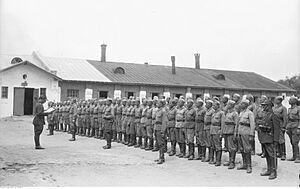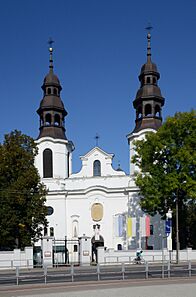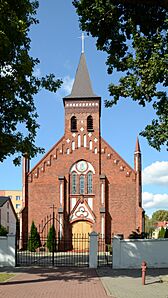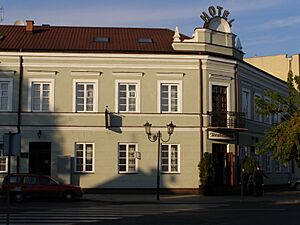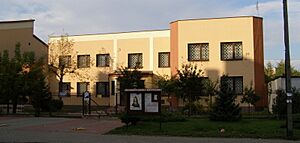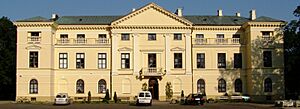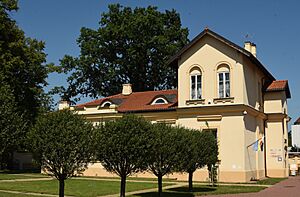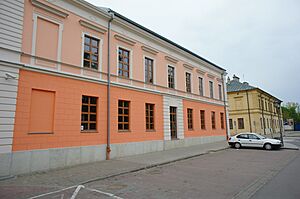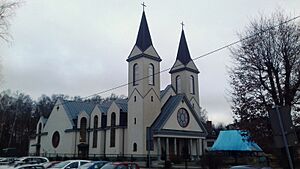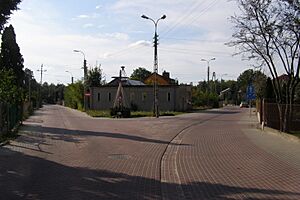Mińsk Mazowiecki facts for kids
Quick facts for kids
Mińsk Mazowiecki
|
|||
|---|---|---|---|
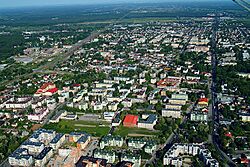
Aerial view of Mińsk Mazowiecki
|
|||
|
|||
| Country | |||
| Voivodeship | |||
| County | Mińsk | ||
| Gmina | Mińsk Mazowiecki (urban gmina) | ||
| Established | 14th century | ||
| Town rights | 1421, 29 May | ||
| Area | |||
| • Total | 13.12 km2 (5.07 sq mi) | ||
| Elevation | 147 m (482 ft) | ||
| Population
(2020)
|
|||
| • Total | 40,999 | ||
| • Density | 3,124.9/km2 (8,094/sq mi) | ||
| Time zone | UTC+1 (CET) | ||
| • Summer (DST) | UTC+2 (CEST) | ||
| Postal code |
05-300, 301, 303
|
||
| Area code(s) | +48 025 | ||
| Car plates | WM | ||
| Website | http://www.minsk-maz.pl | ||
Mińsk Mazowiecki is a town in eastern Poland. In 2020, about 41,000 people lived there. It is part of the Masovian Voivodeship and is close to Warsaw, Poland's capital city. Mińsk Mazowiecki is also the main town of Mińsk County. It's located about 38 kilometers (24 miles) from the center of Warsaw.
Contents
- What's in a Name? The Story of Mińsk
- Where is Mińsk Mazowiecki Located?
- A Quick Look at Mińsk Mazowiecki's History
- Historic Places to See in Mińsk Mazowiecki
- What is the Economy Like?
- How Many People Live Here?
- Learning in Mińsk Mazowiecki: Education
- Local Government and Services
- Keeping Mińsk Mazowiecki Safe
- Fun and Culture: Sports and Arts
- Places of Worship: Religions
- Getting Around: Public Transport
- How the Land is Used
- Historical Parts of the City
- Military Presence
- Friendship Across Borders: Twin Towns
- Famous People from Mińsk Mazowiecki
- Images for kids
- See also
What's in a Name? The Story of Mińsk
The name Mińsk comes from the Mienia River. The river's name comes from an old Polish word, mienić, which means 'to shine'. The second part of the name, Mazowiecki, tells us that the town is connected to the historical region of Mazovia. This helps people know it's different from Minsk, the capital city of Belarus.
Where is Mińsk Mazowiecki Located?
Mińsk Mazowiecki is in the historical region of Mazovia. It's in the eastern part of the Masovian Voivodeship. The town is about 37 kilometers (23 miles) east of Warsaw's city center. It's also only about 20 kilometers (12 miles) from Warsaw's edge.
A Quick Look at Mińsk Mazowiecki's History
People first mentioned a settlement here in the 14th century. It was a place where people traded goods. On May 29, 1421, Duke Janusz I of Warsaw gave Mińsk special town rights. This was a big step for the settlement.
The first wooden church was built in 1422, but it no longer exists. In 1549, another town called Sendomierz grew up nearby. Later, in 1695, Sendomierz joined with Mińsk. The 18th century was a difficult time for Mińsk, as the Polish–Lithuanian Commonwealth faced challenges.
Mińsk Under Different Rulers
After Poland was divided in 1795, Austria took control of the town. But after a Polish victory in 1809, Mińsk became part of the Duchy of Warsaw. This duchy was a short-lived Polish state. In 1815, it became part of Congress Poland, which was controlled by Russia.
During the November Uprising in 1831, Polish fighters battled Russian troops in Mińsk. These battles happened on April 26 and July 14.
Growth and Change in the 19th Century
In 1866, the Mińsk County was created. The first train arrived in Mińsk that same year, connecting it to the Warsaw–Terespol Railway. In 1867, the town's name changed to Nowomińsk. The Dernałowicz Family became the last private owners of the town in 1870. The first bookstore in eastern Mazovia opened in Mińsk in 1886.
The 20th Century and Beyond
Around 1910-1912, the Maria Grochowska's School opened. In 1914, the old church was reopened after being rebuilt. The town's hospital opened the following year.
During World War I, German forces occupied Mińsk from 1915 to 1918. In 1916, the town was renamed Mińsk Mazowiecki. In 1918, Poland became independent again, and Mińsk was back under Polish control.
During the Polish–Soviet War in 1920, Russian forces briefly occupied the town. But Polish forces quickly recaptured it the next day. Marshal Józef Piłsudski, a famous Polish leader, even stayed in the town on August 18, 1920. Mińsk Mazowiecki grew a lot between the World Wars. In 1937, the first electric train arrived. The 7th Lublin Uhlan Regiment, a military unit, was based here. Today, there's a museum in town dedicated to this unit.
World War II and After
On September 13, 1939, the Battle of Mińsk Mazowiecki took place. Polish forces, led by General Władysław Anders, fought against the invading German army. After this battle, the town came under German occupation. Many Poles were forced to move here from other parts of Poland.
In October 1940, the Germans created the Mińsk Mazowiecki Ghetto. This was a place where Jewish people were forced to live. On July 21, 1942, the ghetto was closed down. Most of the Jewish residents were tragically sent to the Treblinka extermination camp and sadly killed. This was part of the terrible events of the Holocaust. Some brave Poles who helped Jewish people were freed from the local prison by the Polish resistance.
On July 30, 1944, the Polish underground Home Army freed Mińsk Mazowiecki. However, Soviet forces occupied the town the very next day. After the war, Mińsk was returned to Poland, but with a communist government. This government stayed in power until the 1980s.
In 1952, the ZNTK Mińsk Mazowiecki factory, which builds and repairs trains, was founded. Mińsk Mazowiecki became a military base in 1957. A new train station opened in 1979. In 1985, events related to the Solidarity movement took place. In 1990, Zbigniew Grzesiak was chosen as Mayor in the first free elections after World War II. The Mińsk County was re-established in 1999.
Jewish History in Mińsk
In 1768, Jewish people were allowed to live permanently in Mińsk. From the 19th century until the 1930s, the Jewish community grew a lot. Before World War II, thousands of Jewish people lived in Mińsk. They had a main synagogue and smaller places of worship. The Novominsk Hasidic dynasty, a Jewish religious group, started here in the late 1800s.
Sadly, during World War II, the Germans created the Mińsk Ghetto. On July 21, 1942, it was closed. Most of the Jewish people were sent to the Treblinka extermination camp and tragically killed. The remaining Jewish people were killed in Mińsk in 1943.
Historic Places to See in Mińsk Mazowiecki
Mińsk Mazowiecki has many interesting historical sites:
- The old layout of the medieval town.
- The Palace of the Doria Dernałowicz Family: This palace was likely built in the 17th century. It was later changed to the classicism style. It also has a beautiful park.
- The Church of the Nativity of The Blessed Virgin Mary: Built in the 17th century, this church was later updated in the neo-baroque style. It has lovely interior decorations and a cemetery.
- The old and new county halls, both from the 19th century.
- The post office, also from the 19th century.
- The church of the Mariavite Church, built in 1911.
- Many residential buildings from the 19th and early 20th centuries.
- The Jewish cemetery.
- Some school buildings from the early 20th century.
What is the Economy Like?
Mińsk Mazowiecki has a busy economy with different types of businesses:
- Trade: You can find large stores like Carrefour, many supermarkets, and other shops. There's also a market.
- Services: The town has ten banks, many fast-food places, pubs, and restaurants. There are three hotels, construction companies, car repair services, and satellite communication businesses.
- Industry:
- ZNTK "Mińsk Mazowiecki" (now part of PESA SA) works on maintaining and repairing trains.
- Fabryka Urządzeń Dźwigowych makes cranes and other heavy machines.
- Other industries include cotton products, yachts, shoes, and foil.
How Many People Live Here?
Mińsk Mazowiecki has grown a lot over the years.
| Age / Gender | Number | Total |
|---|---|---|
| Male 0–18 | 3,978 | 7,618 |
| Female 0–18 | 3,640 | |
| Men 18–65 | 12,283 | |
| Women 18–60 | 12,496 | |
| Work-age | 24,779 | |
| Retired men | 1,572 | |
| Retired women | 3,560 | |
| Retired-age | 5,132 | |
| All | 37,529 |
| Year | Number | Year | Number |
|---|---|---|---|
| 16th century (second half) |
3,500-4,000 | 1660 | 1,000 |
| 1777 | 456 | 1827 | 750 |
| 1880 | 2,940 | early 20th | 4,771 |
| 1910 | 5,794 | 1921 | 10,689 |
| 1939 | 15,103 | 1945 | 10,500 |
| 1971 | 24,700 | 1992 | 34,000 |
| 1995 | 35,068 | 2000 | 35,761 |
| 2006 | 37,529 |
Learning in Mińsk Mazowiecki: Education
The town has many schools and learning centers:
- Józef Majka College of Social Science (a Catholic college)
- Stanisław Staszic Lifelong Learning Center
- University of Third Age (for older adults)
- Polska Macierz Szkolna Gymnasium and High School
- Salesian Elementary, Gymnasium and High School (Catholic schools)
- Kazimierz Wielki Professional High School
- Powstańcy Warszawy Professional High School
- High School of Economy
- Maria Skłodowska-Curie High School
- Three public gymnasiums
- Four public elementary schools
- Over ten preschools (six of them are public)
- A special school for children with specific needs
- A clinic for psychological and educational support
Local Government and Services
Mińsk Mazowiecki is home to several important offices:
- Regional Bureau of Environmental Protection Inspection
- Point of Conscription (for military service)
- Above Forester Bureau (Nadleśnictwo Mińsk)
- County, city, and local government offices
Keeping Mińsk Mazowiecki Safe
The town has important services to keep everyone safe:
- The Police Department of Mińsk County has two buildings and many cars.
- The Fire Department of Mińsk County has modern fire engines.
- The Public Hospital of Mińsk County provides healthcare.
Fun and Culture: Sports and Arts
Culture
- The House of Culture hosts many events.
- There is a School of Art.
- The town has two libraries and two museums.
- You can also enjoy movies at the Cinema.
- Several magazines are published in Mińsk.
Sports
- The Miejski Ośrodek Sportu i Rekreacji (public sport and recreation department) has two stadiums and an ice rink.
- The Mazovia-ZNTK club has a football team and other sports teams.
- There are also other sports clubs in town.
Places of Worship: Religions
Mińsk Mazowiecki has several religious communities:
- The Roman Catholic Church has four parishes and other groups.
- The Mariavite Church has one parish.
- There is one Baptist congregation.
- There is one Mennonite congregation.
Getting Around: Public Transport
- Train Station: There are regular train services to Warsaw (39 trains daily in one direction). You can also find direct connections to many other cities in Poland and even to Moscow.
- Bus Services: Two regular bus services connect Mińsk Mazowiecki to Warsaw.
How the Land is Used
The total area of Mińsk Mazowiecki is about 13.12 square kilometers (5.07 square miles). Here's how the land is used:
- Residential areas (homes): 30%
- Industrial areas (factories): 6%
- Communication (roads, railroads): 15%
- Agricultural land (farms): 29%
- Parks: 5%
- Other uses: 15%
Historical Parts of the City
Mińsk Mazowiecki is made up of older towns and villages that joined over time:
- Mińsk: The original old town.
- Sendomierz: Founded in 1549, it joined Mińsk in 1695.
Some areas were built as part of Mińsk:
- Nowe Miasto – Miasto Ogród (New Town – Garden Town): Founded in 1936.
- Modern estates built after 1945.
Villages that became part of Mińsk:
- Kędzierak (joined partly in 1954 and fully in 1984)
- Stankowizna (joined in the 19th or 20th century)
- Anielina (joined around the same time as Kędzierak)
- Górki (joined in the 18th century)
- Goździk (joined during World War I)
- Kolonia Stasinów (joined in 1936)
- Pohulanka (joined partly in 1936)
- Sewerynów (joined around the same time as Kędzierak)
Military Presence
Mińsk Mazowiecki has a military presence:
- Military police
- The 23rd Air Base, which has MIG-29 aircraft.
Friendship Across Borders: Twin Towns
Mińsk Mazowiecki has "twin town" relationships with several cities around the world. These friendships help people from different countries learn about each other's cultures.
 Borodianka, Ukraine
Borodianka, Ukraine Krnov, Czech Republic
Krnov, Czech Republic Lacey, United States
Lacey, United States Pefki, Greece
Pefki, Greece Saint-Égrève, France
Saint-Égrève, France Telšiai, Lithuania
Telšiai, Lithuania
Famous People from Mińsk Mazowiecki
Many notable people have connections to Mińsk Mazowiecki:
- Julian Grobelny: Recognized for helping Jewish people during the Holocaust.
- Louis B. Mayer: A famous Hollywood film producer.
- Czesław Mroczek: A Polish politician.
- Teresa Wargocka: A Polish politician.
- Moshe Carmel: A politician in Israel.
- Stefan Żeromski: A well-known writer.
- Jan Himilsbach: An actor and author.
- Leyb Rokhman: A Yiddish writer in Israel.
- Hanna Dunowska: An actor.
- Victor Prus: An architect in Canada.
- Yeshurun Keshet: An Israeli poet, essayist, translator, and literary critic.
- Jacques Kalisz: An architect in France.
- Stanislav Redens: A secret police officer in the Soviet Union.
- Hermann Birnbach: Subject of a Stolperstein (a memorial stone) in Nordhausen.
- Marek Piotrowski: A World Champion in Kickboxing.
- Rafał Jackiewicz: A boxer.
Images for kids
See also
 In Spanish: Mińsk Mazowiecki para niños
In Spanish: Mińsk Mazowiecki para niños





